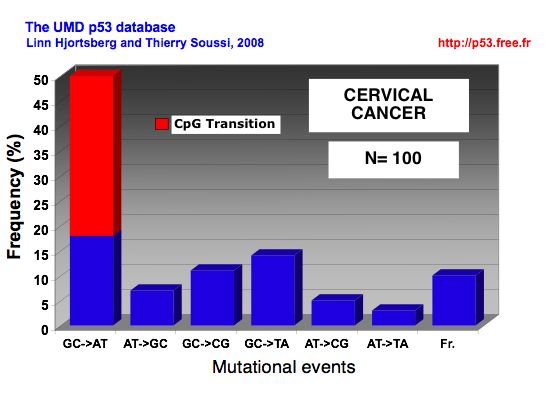


 |
|||||||
 |
 |
||||||
p53 databaseImprove p53 mutation detection and report p53 mutation and cancer
|
p53 MUTATIONS IN CERVIX CANCER
|
 |
DISTRIBUTION OF p53 MUTATIONS IN CERVIX CANCER |
 |
MUTATIONAL EVENTS IN CERVIX CANCER |
REFERENCES
• Busby-Earle RMC, Steel CM, Williams ARW, Cohen B and Bird CC (1992) Papillomaviruses, p53, and cervical cancer. Lancet 339: 1350.
• Borresen AL, Helland A, Nesland J, Holm R, Trope C and Kaern J (1992) Papillomaviruses, p53, and cervical cancer. Lancet 339: 1350-1351.
• Crook T, Wrede D, Tidy JA, Mason WP, Evans DJ and Vousden KH (1992) Clonal p53 mutation in primary cervical cancer - association with human-papillomavirus-negative tumours. Lancet 339: 1070-1073.
• Crook T, Wrede D and Vousden KH (1991) p53 point mutation in HPV negative human cervical carcinoma cell lines. Oncogene 6: 873-875.
• Fujita M, Inoue M, Tanizawa O, Iwamoto S and Enomoto T (1992) Alterations of the p53 gene in human primary cervical carcinoma with and without human papillomavirus infection. Cancer Res 52: 5323-5328.
• Howley PM (1991) Role of human papillomaviruses in human cancer. cancer Res. 51: 5019s-5022s.
• Mcgregor JM, Levison DA, Macdonald DM and Yu CC (1992) Papillomaviruses, p53, and cervical cancer. Lancet 339: 1351.
• Scheffner M, Munger K, Byrne JC and Howley PM (1991) The State of the p53 and retinoblastoma genes in human cervical carcinoma cell lines. Proc Natl Acad Sci USA 88: 5523-5527.
• Scheffner M, Werness BA, Huibregtse JM, Levine AJ and Howley PM (1990) The E6 oncoprotein encoded by human papillomavirus type-16 and type-18 promotes the degradation of p53. Cell 63: 1129-1136.
• Zur Hausen H and Schneider A (1987) The role of papillomaviruses in human anogenital cancer. Papovaviridae 2: 245-263.
 |
Home | Our Work |p53 Info| p53 Database | p53 Link | Contact us |